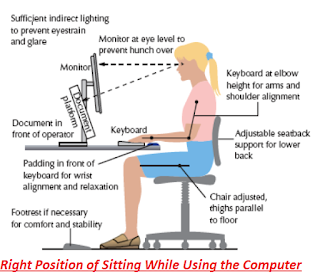We have allowed many facilities to enter in our life but it has also caused a bad effect on our body. Health is the one thing that cannot be replaced by anything but we have become enemies of ourselves. We are giving our health to technology that is replaceable. So to enjoy the luxury of technology as well as to stay healthy , one should keep both things in order. The thing that has really obtained a very important place in our life is laptop . The problem with laptops is that they’re designed with portability in mind rather than what’s good for your back, neck, and wrists .However, there are several things you can do to improve your laptop setups.
Don't slouch: Despite the name “laptop”, you want to avoid propping your laptop on top of your lap as this requires you to slouch down to see the screen. If you have to work on your lap, such as while you’re on the train, at least put the laptop on top of your computer bag or briefcase so you can raise it up slightly.
 |
Place the screen at eye level:. Ideally, set your laptop height and screen angle so you can easily view the screen without bending or rotating your neck, and put it about an arm’s length in front of you. To do this, you will usually need to elevate the laptop a few inches above your desk, which you can do by placing it on a stable support surface such as a laptop stand or a thick book.
Use a separate keyboard: When using the laptop for extended periods, use an external, full-sized keyboard and position it at a height that allows your shoulders and arms to be in a relaxed position, with your elbows at a 90° angle when typing. Ideally, place the separate keyboard on a keyboard tray beneath your desk surface to help your wrists stay in a neutral (flat) position.
Use a separate mouse: Be kind to your wrists by using an independent mouse rather than the mouse that’s incorporabutted into your laptop keyboard. Place the mouse on an adjustable-position mouse platform so you can keep it near your body and keep your wrist flat while using it.
Recline slightly:If you don’t want to use a separate keyboard and mouse, an alternative is to find a chair that allows you to recline slightly. This will allow you to position the laptop keyboard and mouse with the least strain on your neck. Angle the screen slightly upward so that you can view the screen without having to bend your neck too far down, and make sure your lower back is supported.
Use a larger screen:Get a laptop with the largest screen possible for your needs to avoid the stressful posture that results from straining to see the text on a small screen. If you find yourself straining to see your screen, increase the font size.
Prop up your feet: If you have to raise your chair so that your arms and wrists are positioned comfortably, check to see how your legs are angled. Your knees should be at about the level of your hips. If your hips are too high, you need to put a footrest or small box under your feet to prop them up and keep excess strain off your lower back.
Use a good chair: The type of office chair you use is critical. Any office chair that is fully adjustable and has lumbar support will work, but you need to be sure to set it up correctly. See How to Set up Your Office Chair for more information.
Give yourself a rest: Take brief breaks every half hour; at the very least take your eyes off the screen and let them rest on something in the distance. The best approach is to do some simple stretches while at your desk, such as stretching your neck, shoulders, arms and legs. Every one or two hours, leave your desk to walk around to get your blood flowing and move your muscles.









No comments:
Post a Comment